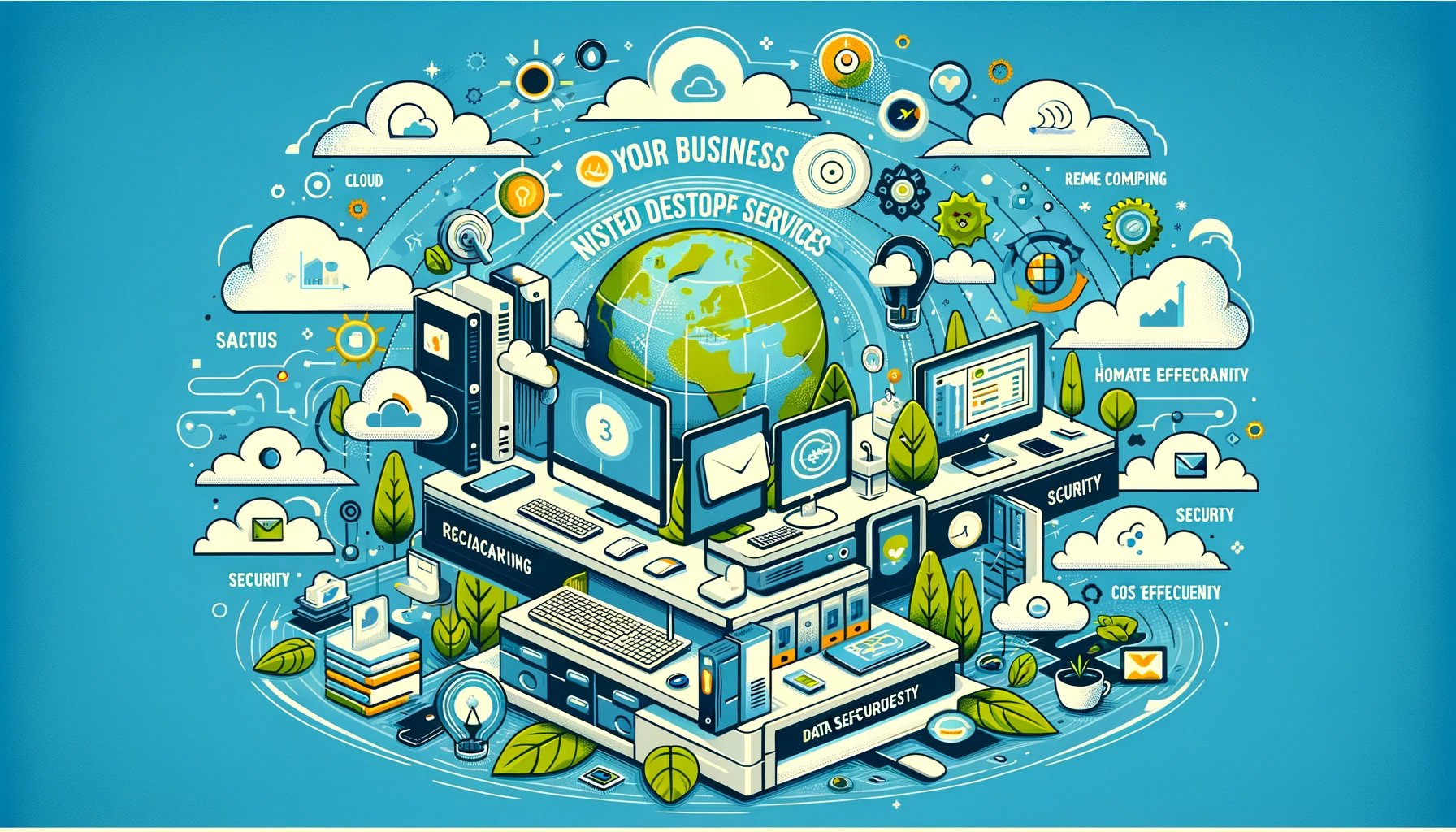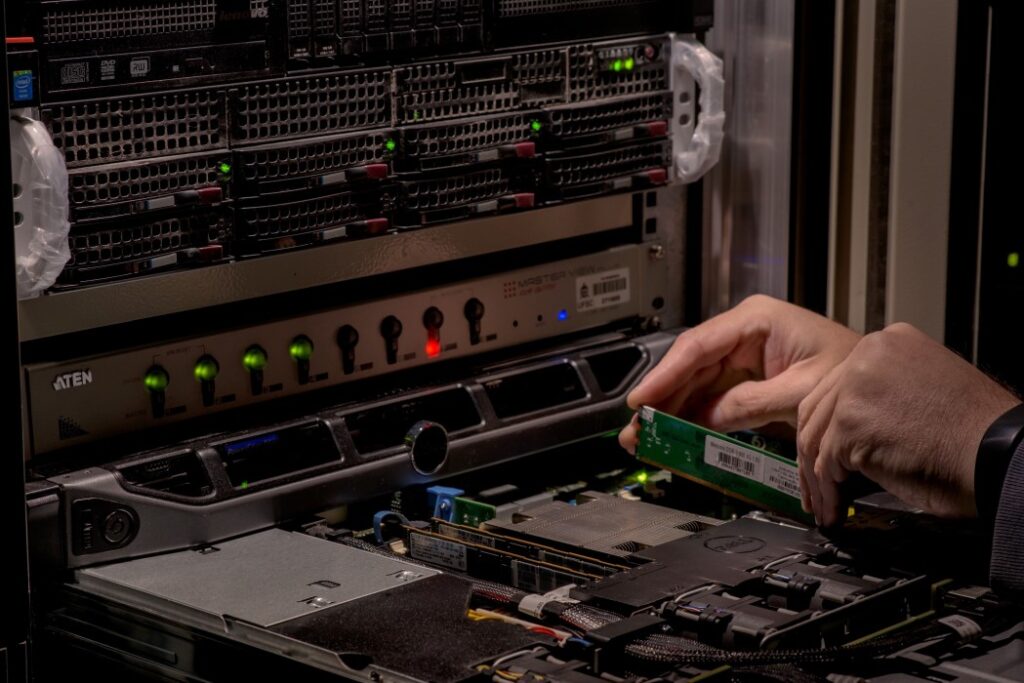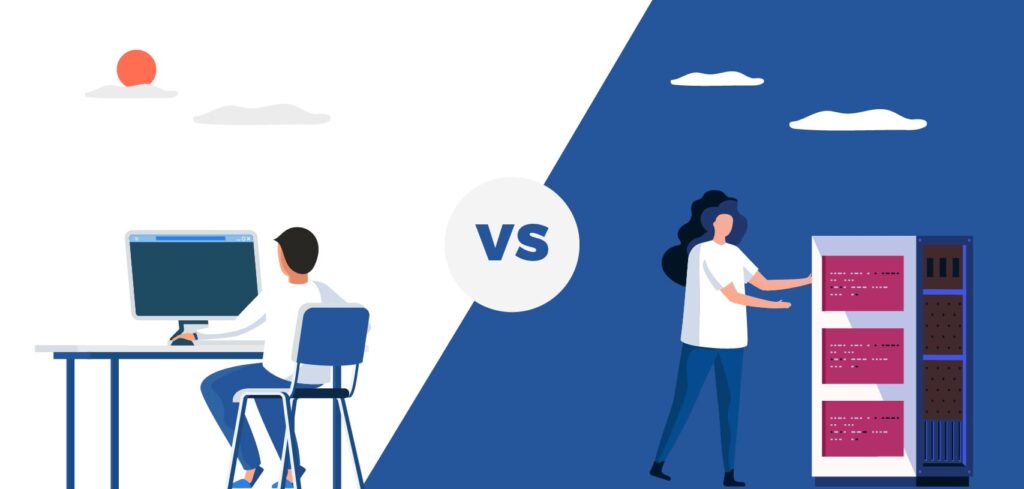Why Your Business Needs Hosted Desktop Services

Any traditional office environment will house dozens if not hundreds of desktop computers used by employees to manage their work every day. Many thousands of businesses rely on these machines for their essential day-to-day operations, and without them they would incur massive losses in working hours, productivity, and ultimately revenue. Large-scale companies have even gone bankrupt due to their IT infrastructure failing.
Yet instead of changing to a more reliable method of working, countless organisations around the world are still relying on their outdated, inferior computers for their vital operations. Upgrading systems is a big undertaking that takes a lot of money, time, and stress. As a result, many companies will delay upgrading systems for years or even decades – which can lead to further problems.
What many don’t realise is that there’s a different solution to this problem that doesn’t require huge sums of money or assistance from IT experts. With the introduction of hosted remote desktop systems into the computing world, workers no longer need to rely on the limited resources that their office environment can provide. Companies can use remote desktop environments exactly the same way they would with a local machine, but with a great range of benefits.
In this blog post we aim to explain exactly what a hosted desktop service is, how you can get started with it, and the benefits to using it compared to a traditional client-side computer system.

What is a hosted desktop system?
A hosted desktop system is a business cloud computing service that provides an alternative to conventional desktop machines by allowing the user to access a full desktop computer environment stored in a hosting provider’s data centre, over an internet connection. Hosted desktop machines will appear identical to a physical desktop machine to the end-user, as the user has full control over a desktop environment and all associated applications.
End users will connect to the hosted desktop machine over an internet connection, typically with an internet browser or installable application. They’ll then have full control over the machine, just like they would with a physical computer. For anyone familiar with using remote desktops, the concept is much the same.
Hosted desktop machines are managed and maintained entirely by the hosting provider rather than the organisation using the machine. All equipment such as servers, routers, and switches are handled by the hosting provider. This removes the need for offices to maintain a sizable IT infrastructure as the workload is being handled elsewhere.
You will typically pay a monthly fee, often calculated on a per-user basis, to rent the remote desktop services from a provider who will then grant you access to the relevant machines in their data centre. Your data and business applications can be accessed anywhere with an internet connection, so you don’t need to rely on your local hardware.

Hosted Desktop vs Client-side Computing
When discussing remote hosted desktop systems there can be some confusion on what the differences are compared to a regular client-side computer. The fact that using a hosted desktop feels nearly identical to a traditional computer probably doesn’t help!
There are a number of key differences between remote hosted desktop systems and regular client-side computers, so let’s explain some of the most important areas.

Hardware
One of the biggest limitations that businesses face when using regular computers is the lack of powerful hardware to utilise. Most offices are only equipped with basic barebones desktop computers that will run simple programs needed for the most common tasks such as word processing and spreadsheet management.
It’s uncommon to see employees using high-end performance hardware in their desktop machines, outside of a few industries like animation and games development. Often the costs associated with powerful hardware is a major deterrent to upgrading.
Hosted desktop machines are often equipped with far superior hardware than client-side machines. Since the hosting provider will have better equipment at their disposal, as well as being able to use a data centre environment, they’re not limited to basic machines. On top of that, they don’t need to supply machines for hundreds of employees, so the costs are lower.

Software
In a conventional client-server computing infrastructure, each individual machine will hold its own operating system and associated software. Each application and piece of software has to be installed individually on each machine, which can consume many man-hours in configuration and administration.
Patching software is something that also causes issues for many organisations. Each computer will need to have it’s software patched and there’s usually no system in place for updating entire offices in one go.
With a hosted desktop machine, no software is held on the desktop machine – it all resides on the server. This means that not only will you be able to more easily install and configure new software, it also makes patching and administration a breeze. Global updates can be applied quickly and easily from the central server with little hassle.

Security
As you are probably already aware, security is a massive issue for IT infrastructures around the world. Every day hackers are finding vulnerabilities, exploits, and backdoors for hundreds of computer systems in organisations around the world. Desktop computers can be particularly prone to malware and malicious attacks in office environments.
That isn’t to say that it’s impossible to secure your company’s IT systems. But, it will set you back a considerable amount of money, and you’ll need to hire a cyber security specialist to audit your company.
Hosted desktop machines have the advantage in terms of security for a few reasons. Since the machines aren’t physically located in your workplace, you won’t have unwanted parties accessing machines. Your hosting provider will make use of firewalls, access control, and various other methods to ensure your machine’s safety. On top of that, regular backups are run, so if anything goes wrong you can easily revert back to a working state, without needing to rely on your local backups.

How can I get started with a remote hosted desktop?
Getting started with a hosted desktop setup is simpler and faster than you might think. Unlike a traditional computer system, you don’t need to spend ages configuring hardware and installing applications!
First you’re going to need to choose the right provider. This is very important so you should spend some time researching and finding which provider offers what meets your requirements. Due to the sheer amount of providers offering hosted desktop services, it can seem overwhelming at first. If you don’t know what to look for, take a look at our blog post.
Once you’ve decided on a hosting provider the next step is choosing the right hosted desktop plan for you. Again, there’s a massive variety of packages to choose from, so you’ll need to determine first what your requirements are, and then see what plan matches your needs. You should be considering:
- Operating system
- Processor
- Hard drive
- RAM
- ETC
Then all that’s left to do is to get started! Your provider will set your hosted desktop up for you and provide you with access details, so you can start using your system right away.
As an example, our hosted desktop systems are configured with a full Windows 10 desktop environment, between 4 and 8GB of system memory, and between 25 and 100GB of SSD storage. This equips each user with ample space and resources to run any desktop software they require for their business.
Benefits of using a hosted desktop system
As we’ve already established, switching your business to a remote hosted desktop environment can bring a multitude of benefits to the efficiency and productivity of your workforce. You’ll be able to achieve much more than you would with a traditional desktop machine, as well as saving money at the same time.
If you’re still not convinced, then take a look at what we think are some of the biggest benefits to using a hosted desktop system versus a traditional desktop computer.

Work wherever you are
Perhaps one of the most obvious benefits of using a hosted desktop system is the ability to work remotely, wherever you are. As long as you have an internet connection you’ll be able to access your desktop system and use it as if it was right next to you. All of the applications you usually rely on will be right there for you to start using whenever you need.
Gone are the days of dragging around your work machine home with you when you need to work from home, or spending time setting up software on your home computer. With a hosted desktop machine, you can use the one system for everything work related from any location in the world.
Many hosted desktop systems even allow you to login and control the machine from your phone or tablet!
Not only does a hosted desktop allow you to take your work with you wherever you are, it also makes it much easier to accommodate a change of location if your office needs to relocate. You don’t need to set up and configure new machines, you can just start working right away.

Save Money
You might think that migrating to a remote hosted desktop setup would set you back lots of money – but you’d be wrong in thinking that.
When ordering your hosted desktop plan, there will be little to no initial investment cost because you don’t need to purchase your own hardware and design the infrastructure. Your hosting provider handles all of that for you. Compare that to a traditional client-side infrastructure where you need to purchase everything yourself, you’re saving money right off the bat.
Running costs will also typically be quite a bit lower with a remote hosted desktop system. While you do usually pay your hosting provider a monthly fee for the service, you don’t need to shell out additional money for maintenance, software updates, and patches.
Utility costs will also be lower if you choose a hosted desktop system. As the hardware isn’t hosted locally, you’ll save money on electricity bills, internet bills, and cooling solutions.

Utilise more powerful hardware
With a traditional client-side computing setup, you’re limited by the performance of the hardware available to you. If your desktop machine is equipped with inferior or poorly performing hardware, as is all too common in office environments, you won’t be able to run resource-intensive or complex applications.
Traditionally, it required a full restructure of your computer systems to be able to run more intensive programs. You’d need to assign a huge budget to this and for many companies it’s just not feasible. Luckily, with a hosted desktop system, this is no longer a problem.
Most remote desktop systems will be equipped with significantly more powerful hardware than you would find in a normal desktop machine. Data centres have access to equipment that can provide much better performance, allowing you to carry out more complex work. Enterprise-grade hardware can provide a massive performance boost to your existing applications as well.

Communicate with your team more effectively
Communicating with your team is the key to an effective business, and a hosted desktop system helps facilitate that.
In a typical office environment, problems can arise when employees need to travel to different locations, for work reasons or otherwise. Sharing work documents and files can be problematic with employees using different systems across various machines. Valuable time is often lost trying to resolve these problems.
With a remote hosted desktop system, you’ll be able to hold all of your team’s files, documents, and applications in one central location. This means that whenever your team needs to share work they can do so easily, wherever they are, without any hassle. Users won’t need to go into their workplace and access their physical machines to share important files, they can do it from any location.

Protect your data with enhanced security, reliability, and resilience
As we’ve already established, your company’s data is incredibly valuable and it’s incredibly important to secure this data properly.
What you might not understand is just how much more secure your data is when it’s stored with a good hosting provider, compared to being stored locally.
When you’re storing your data on-site, you’re opening yourself up to a variety of security vulnerabilities. If you don’t implement access-control, then anyone can come in and tamper with your servers. If you’re not running regular backups, your systems might not be able to recover from a fatal crash.
Hosting providers will implement strict security measures throughout their data centre, as well as on the machine you’re renting from them. Hardware firewalls will often be in place to prevent and malicious activity in the network, and access-control measures will be in place to prevent any unauthorized parties from accessing the machines. Backups will also be run regularly and stored offsite, ready to restore from at any time.
You can also expect to benefit from higher levels of reliability, as data centre providers often advertise uptime guarantees of over 90%. The infrastructures in place with hosting providers are highly resilient to any types of outages, with backup power supplies and disaster recovery methods in place. Just take our data centre as an example.

In Conclusion
We hope that after reading through this blog post you’ll gain a better understanding of the limitations of traditional client-side computing, how remote hosted desktop services work, and an idea of the wealth of benefits that hosted desktop services can bring to your company.
At UKHost4u we’re always focused on helping your business thrive, and as such, we’ve introduced hosted desktop plans to help you work more efficiently wherever you are. Check out our website to see the plans we offer, and get your first 6 months half price!

